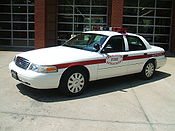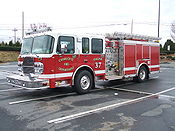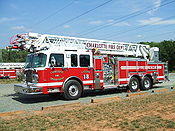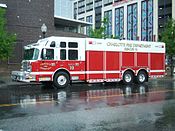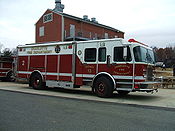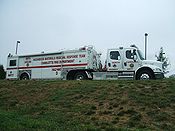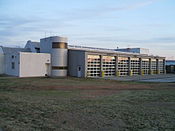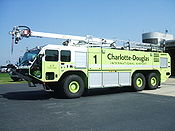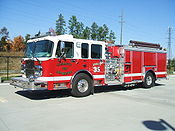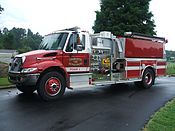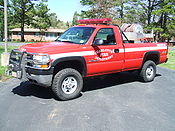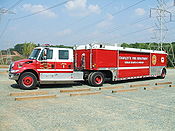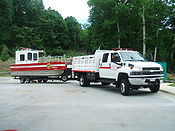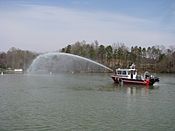- Charlotte Fire Department
-
Charlotte Fire Department 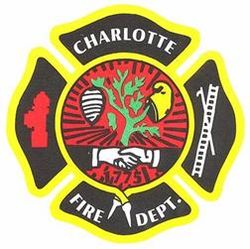
Established August 1, 1887 Staffing Career Strength 256 (Daily) Stations 41 Engines 41 Trucks 15 Rescues 2 EMS Level BLS Fire chief Fire Chief Jon B. Hannan Website www.CharlotteFire.org The Charlotte Fire Department provides fire suppression, emergency medical services, technical rescue, hazardous materials mitigation, disaster response, code enforcement, fire investigations, and public education for a population of approximately 756,000 over an area of about 300 square miles (780 km2) in the city limits of Charlotte, North Carolina[1].
Contents
About the Department
The Charlotte Fire Department began as robust volunteer firefighters in the 1800's. In the summer of 1887, the City's Board of Alderman voted to hire a full-time Fire Marshal. Today the Charlotte Fire Department approaches its 125th year of service to the community. The Charlotte Fire Department is operating out of 41 fire stations, including 2 stations at Charlotte-Douglas International Airport. Their Fire Chief, Jon B. Hannan, oversees a total of 1,164 personnel, of that 1,044 being firefighters.
Organization
Administration
The Charlotte Fire Department's Administration Office is located at 228 East 9th Street in uptown Charlotte.
Office of the Fire Chief
- Includes the Administrative Secretary and the Public Affairs Office.
Deputy Chief of Homeland Security
- Responsible for Communications Division, Emergency Management, Emergency Services Liaison, Special Operations, Training.
Deputy Chief of Fire Operations
- Responsible for Airport Operations Liaison, Operations, Recruitment.
Deputy Chief/Fire Marshal
- Responsible for Fire Prevention, Fire Investigation, IT, Fire & Life Safety, City Services Liaison.
Deputy Chief of Administration
- Responsible for Administration, Civil Service Board Liaison, Health & Safety, Logistics Division.
Administration
The Charlotte Fire Department's Administration Office is located at 228 East 9th Street in uptown Charlotte. The Fire Chief's office and the Deputy Chiefs' offices are located here, along with Emergency Management personnel. Other administrative functions include:
- Accounts Payable
- Budget
- Health & Safety
- Human Resources
- Information Technology
- Office of Public Affairs
- Payroll
- Planning
Operations Division
- The Charlotte Fire Department's 1,044 firefighters operate from 41 Fire Stations, in 8 Battalions, covering nearly 300 square miles (780 km2).
Fire Prevention Bureau
- The Fire Prevention Bureau is responsible for the enforcement of the North Carolina Fire Code and other applicable standards and ordinances on both new construction and existing buildings. This is accomplished by the efforts of several branches with-in the division that include fire plans examiners, fire inspectors, and an inspector responsible for overseeing the City's fire hydrant program.
Fire Investigation Task Force
- The Charlotte Fire Investigation Task Force, led by the Chief Fire Investigator has members from:
-
- Bureau of Alcohol, Tobacco and Firearms
- Charlotte Fire Department
- Charlotte-Mecklenburg Police Department
- State Bureau of Investigations
Public Fire and Life Safety Education
- The Public Fire and Life Safety Education Division of the Charlotte Fire Department plans and conducts community fire and life safety education programs to teach youngsters how to handle fire emergencies.
Training Division
- The Charlotte Fire Department Training Division, at 1770 Shopton Road, provides continuing education for members of the fire department through regular training programs. Fire Recruit School also takes place at the Training Academy which is currently 26 weeks long. The training staff is led by the Chief of Training.
Communications Division
- The Communications Division of the Charlotte Fire Department is a stand-alone 24-hour emergency communications center that is responsible for matching the public's requests with the resources of the Fire Department.
Emergency Management Division
- The Charlotte-Mecklenburg Emergency Management Office (CMEMO) is a local governmental agency which coordinates large-scale emergency situations in Charlotte and Mecklenburg County.
- The agency assists emergency response departments with specialized needs and provides detailed planning procedures for incidents requiring multi-agency participation's.
Logistics Division
- Logistics is a division that provides supplies and support to the Fire Department in a timely manner, 24 hours a day, 7 days a week.
Brief history
The census of 1850, the first to enumerate the residents of Charlotte separately from Mecklenburg County, showed the population to be 1,065. By then, Charlotte covered an area of 1.68 square miles (4.4 km2) and was certainly large enough that bucket brigades were inadequate for fire protection.
The first mention of fire services in the City records occurs in 1845, when the Board of aldermen approved payment for repair of a fire engine.
The volunteers would assemble at the Square to find out where the fire was, then run to its location. The first arriving firemen would go to the station at Trade and College for the engine and then run to the fire. The original volunteers called themselves the Hornets.
The City's first offices were located in a building at North Tryon and East Sixth. Quarters for two fire companies were provided. The Neptune's had the Sixth Street side, and the Independence hook and Ladder had the Tryon Street side. Originally, the hook and ladder truck was too long for the building and had to be housed outside.
Rank Structure
- Fire Chief
- Deputy Fire Chief
- Battalion Fire Chief
- Fire Captain
- Fire Fighter Engineer
- Fire Fighter II
- Fire Fighter I
- Fire Fighter Recruit
Stations
Station Units Location Phone Number Open Date Station 1 Engine 1, Ladder 1, Battalion 1, Field Comm 1, Field Comm 2, MCP 221 N. Myers St. 704-336-2150 1991 Station 2 Engine 2, Ladder 2 1817 South Blvd. 704-336-2580 1907 Station 3 Engine 3, Rescue 3, Battalion 4, Dive 3 6512 Monroe Rd. 704-568-4141 1974 Station 4 Engine 4, Ladder 4, Rehab 1 525 N. Church St. 704-336-4409 1972 Station 5 Engine 5, Brush 5 224 Wesley Heights Way 704-336-2499 1929 Station 6 Engine 6 249 S. Laurel Av. 704-336-2668 1929 Station 7 Engine 7 3210 N. Davidson St. 704-336-2851 1935 Station 8 Engine 8, Engine 42 1201 The Plaza 704-336-2152 1948 Station 9 Engine 9, Tanker 9 4529 McKee Rd. 704-432-6874 Dec-1985 Station 10 Engine 10, Rescue 10, Battalion 3, Dive 10 2810 Wilkinson Blvd. 704-399-2206 Jan-2005 Station 11 Engine 11, USAR 1, Fuel Truck 620 W. 28th St. 704-336-2130 1958 Station 12 Engine 12 420 Inwood Dr. 704-523-3732 1961 Station 13 Engine 13, Ladder 13, Haz-Mat 1, Haz-Mat 2 4337 Glenwood Dr. 704-399-4710 1962 Station 14 Engine 14 114 N. Sharon Amity Rd. 704-364-8253 1962 Station 15 Engine 15 3617 Frontenac Av. 704-568-4484 1965 Station 16 Engine 16, Ladder 16 6623 Park South Dr. 704-554-7363 1966 Station 17 Engine 17, Battalion 8, Blaze 1, Blaze 3, Blaze 5, Blaze 7 5308 Morris Field Dr. 704-359-8259 1985 Station 18 Engine 18, Ladder 18 2337 Keller Dr. 704-399-2933 1970 Station 19 Engine 19 1016 Sardis Lane 704-432-6170 1974 Station 20 Engine 20, Battalion 5, Brush 20 9400 Nations Ford Rd. 704-525-3217 1974 Station 21 Engine 21, Tanker 21 1023 Little Rock Rd. 704-399-1532 1978 Station 22 Engine 22 1917 W. Sugar Creek Rd. 704-597-8840 1978 Station 23 Engine 23, Ladder 23 7400 E. Harris Blvd. 704-536-0331 1978 Station 24 Engine 24, Ladder 24 7132 Pineville-Matthews Rd. 704-542-6071 1981 Station 25 Engine 25, Battalion 6, Foam 1 6741 Pleasant Grove Rd. 704-392-8636 1988 Station 26 Engine 26, Ladder 26 9231 S. Tryon St. 704-588-6752 1989 Station 27 Engine 27, Ladder 27, Battalion 2 111 Ken Hoffman Dr. 704-547-9355 1991 Station 28 Engine 28, Tanker 28 8031 Old Statesville Rd. 704-598-6990 1989 Station 29 Engine 29, Ladder 29, Brush 29 2121 Margaret Wallace Rd. 704-537-9341 1989 Station 30 Engine 30 (Temporary Station) 4707 Belle Oaks Rd. 704-357-3791 1991 Station 31 Engine 31, Ladder 31, Brush 31 3820 Ridge Rd. 704-432-8239 1999 Station 32 Engine 32, Ladder 32, Haz-Mat 3 9225 Bryant Farms Rd. 704-544-3975 1997 Station 33 Engine 33, Ladder 33, Brush 33, Decon 1 2001 Mt. Holly Huntersville Rd. 704-432-0688 Jun-2001 Station 34 Engine 34 2824 Rocky River Rd. 704-432-0935 Nov-2004 Station 35 Engine 35, Tanker 35 1120 Pavilion Blvd. 704-432-0931 2001 Station 36 Engine 36, MOC 1, Haz-Mat 5 2325 W. Mallard Creek Church Rd. 704-432-1782 2004 Station 37 Engine 37, Tanker 37 13828 S. Tryon St. 704-432-3954 23-Feb-2007 Station 38 Engine 38 12100 Shopton Rd. W. 704-353-1275 23-Sep-2008 Fire Boat 38, Dive 38 Boathouse 38 Jun-2009 Station 39 Engine 39, Battalion 7, SMAT 8325 Providence Rd. 704-336-4878 20-Dec-2008 Station 40 Engine 40, Ladder 40, Tanker 40 9720 Harrisburg Rd. 704-432-5159 24-May-2010 Station 41 Blaze 41, Blaze 42, Blaze 43, Blaze 45 5740-B West Blvd. 704-588-0700 19-Jul-2010 Station 42 Engine 42 temporarily located at Station 8. 5620 Central Av. Under Construction Late 2011 (estimation) Apparatus
Battalions
- There are currently eight battalions. 1–8 are in charge of their assigned stations. Battalion 8 was created on May 9, 2009 as the Airport Operations Chief. Battalions 1-7 drive Ford Crown Victoria's. Battalion 8 operate a Chevy Tahoe.
Battalion 1 Battalion 2 Battalion 3 Battalion 4 Battalion 5 Battalion 6 Battalion 7 Battalion 8 (Station 1) Station 22 Station 2 (Station 3) Station 12 Station 18 Station 9 (Station 17) Station 4 (Station 27) Station 5 Station 15 Station 16 (Station 25) Station 14 Station 30 Station 6 Station 34 (Station 10) Station 23 (Station 20) Station 28 Station 19 Station 41 Station 7 Station 35 Station 13 Station 29 Station 26 Station 31 Station 24 Station 8 Station 36 Station 21 Station 42 Station 37 Station 33 Station 32 Station 11 Station 40 Station 38 (Station 39) Engine Companies
- There is an engine company at every assigned station (Station 8 has two). This company main task is to attack the fire with either its 1.75 inch or 2.5 inch hoseline. It also carries 1,200 feet (370 m) of 5 inch supply line. It can also provide in EMS, motor vehicle accidents, ventilation at a fire, RIT and many other tasks. The inner city engine companies have 500-US-gallon (1,900 L) water tanks. The outer area (city line) carry 750 US gallons (2,800 L) of water. All engines carry 30 US gallons (110 L) of class B foam concentrate.
- Below is a chart of the current engine companies as of January 2011. The American LaFrances are being phased out.
Model Water capacity Engine: Spartan/Smeal Pumper 500 US gallons (1,900 L) 1,2,3,4,5,7,8,10,11,12,14,15,17,18,19, 20,22,24,25,27,28,29,32,34,35,39,40
750 US gallons (2,800 L) 9,21,23,26,31,36,37 American LaFrance/General Pumper 500 US gallons (1,900 L) 6,13,16,38,42 750 US gallons (2,800 L) 30,33 Ladder Companies
- There are 15 ladder companies in Charlotte. They all are Spartan/Smeal Aerial, years models ranging from 2001 to 2005 (except for Ladder 40). Ladder 40 is a 2010. They all are quints. What makes it a quint are the 5 tasks: pump, aerial device, ground ladders, hose lines and a water tank. They all carry 370 US gallons (1,400 L) of water and 30 US gallons (110 L) of foam concentrate. It also carries 800 feet (240 m) of 5 inch supply line.
- These trucks use phoenix rescue tools. The aerial ladder length is 105 feet (32 m). Other equipment consist of ropes for high or low angle rescue, cribbing for extrication, EMS supplies, two chain saws for ventilation, a circular saw (K12) to open large holes on metal material and many other equipment.
Rescue Companies
- There are two rescue companies, Rescue 3 and Rescue 10. To become a member on the rescue, rigorous training has to be completed. Training classes are USAR, public safety diver (PSD), trench rescue, swiftwater rescue (SRT) and confined space rescue. These rescue personnel are also EMTs. They usually respond to medical calls when either Engine 3 or 10 is out of service. This is done because rescuers need to be available for special calls.
- They respond to all working fires. These two trucks are the only vehicles in the CFD that carry an SCBA refill cascade station. They also use phoenix rescue tools.
Haz-Mat Companies
- Station 13 and 32 personnel are Haz-Mat technicians. To become one they go under the same training as the rescue personnel with the exception of public safety diver. But to add onto that are multiple Hazardous Material classes.
- There are four haz-mat companies in Charlotte. These companies are operated from either an engine or ladder company. Haz-Mat 1 is cross manned by Engine 13. Basically when there is a haz-mat situation, the crew of Engine 13 swap there gear onto Haz-Mat 1 and proceed to the scene, putting Engine 13 out of service. Haz-Mat 2 is cross manned by Ladder 13. These two trucks cover the north Charlotte and uptown area.
- Haz-Mat 3 is a vehicle owned by the state. Ladder 32 cross manned the vehicle. It responds as Haz-Mat 3 in South Charlotte at a city level. If there is a state level emergency, it responds as Regional Response Team 7 (RRT-7) The following counties are covered by RRT-7: Alexander, Anson, Cabarrus, Catawba, Cleveland, Gaston, Iredell, Lincoln, Mecklenburg, Rowan, Stanly, and Union counties.
- Engine 32. The apparatus is longer and have more compartment space then the average engine apparatus. It is structural response engine that also is equipped with tools and monitoring equipment for hazmat calls.
- Haz-Mat 5 is not cross manned by a company. This vehicle was stored outside in the back at Station 32, but moved to 36 due to the cold weather and the hot summer heat. This vehicle holds extra equipment for Haz-Mat 3. Its usually called out at the state level, also as RRT-71. Station 36 personnel are not Haz-Mat certified, but do carry a Class-A drivers license.
Fire Station 17 is located at CDIA runway 36R-18L.
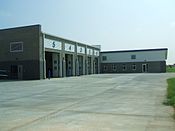 Fire Station 41 is located at CDIA the Sierra taxiway.
Fire Station 41 is located at CDIA the Sierra taxiway.
ARFF Airport Companies
- Fire Station 17 is located at Charlotte/Douglas International Airport at runway 36R-18L. The facility is owned by the City of Charlotte, Aviation Department but the CFD firefighters operate Blazes 1, 2, 5, and 7 on a daily basis. Battalion 8 and Engine 17 are also housed at Station 17. All personnel are ARFF certified. Blazes 1, 2, 5, 7, 41 and 45 are owned by the City of Charlotte. Blazes 4, 42, 43, 46, 18, and Rescue 5 are owned by the North Carolina Air National Guard (NCANG). There are eleven firefighters and one Battalion Chief at Station 17.
- Fire Station 41 is located on the west side of the Airport property between runways 36L-18R and 36C-18C. This new station opened July 2010 with 5 drive thru bays. The new station is owned by the NCANG. Blazes 41, 42 and 43 are currently in service with seven CFD personnel on duty 24 hours. Everyone assigned to the station is also ARFF certified.
Unit Owner Make/Model Information Blaze 1 City of Charlotte Oshkosh/Striker 3000 Water, Foam, PKW, Halotron Blaze 2 City of Charlotte Emergency One/Titan Water, Foam Blaze 4 NCANG Ford Excursion Command Vehicle Blaze 5 City of Charlotte Chevrolet 3500 Pick-Up Rescue Truck/Extrication Equipment Blaze 7 City of Charlotte Emergency One/Titan Water, Foam, PKW Blaze 8 City of Charlotte Chevrolet Tahoe Battalion 8 Blaze 17 City of Charlotte Spartan/Smeal Pumper Engine 17 Blaze 18 NCANG International/KME Water Blaze 41 City of Charlotte Emergency One/Titan Water, Foam, PKW Blaze 42 NCANG Oshkosh Water, Foam Blaze 43 NCANG Oshkosh/Striker 1500 Water, Foam, PKW Blaze 45 City of Charlotte Chevrolet 2500 Pick-Up Rescue Truck/Extrication Equipment Blaze 46 NCANG Emergency One/Teledyne Water, Foam, PKW Rescue 5 NCANG Ford F-550/Pierce Contender Rescue Truck Tankers
Water Tankers
- The tankers are specially designed as a regular engine apparatus. The only difference is that it longer, it holds a drop tank, it has the ability for the driver to deliver water with out leaving the cabin and other features. There are six tankers spreading around Charlotte. They each have a 1500 gpm Waterous water pump, carry 1,000 US gallons (3,800 L) of water and 300 US gallons (1,100 L) of foam concentrate.
- The idea of ordering these tankers was back in 2005. In the past if the city was overrun with calls (ex. multiple flood locations with people trapped, multiple box alarms in the city) a reserve engine would drive to logistics, gear up the truck, put four operation personnel on board and start it as a temporary engine company. Well the department decided to make trucks ready to go if ever needed, plus the older tankers were soon needed to be swapped out with new rigs.
- In 2006 they started with two trucks, 71 and 72. 71 was at Station 9, 72 at Station 28. In 2007, 73 went to Station 21 and 74 at Station 35. The 70s numbers were used because if a tanker is needed in Charlotte for water or foam support, it responds as (ex. Tanker 71). If the truck is responding to calls with four personnel on board in Charlotte, its (ex. Engine 74). But if a fire department in another county is calling for assistance, the closest truck would respond as (ex. Engine 73). The numbers changed in early 2009, placing a "Tanker" decal and the stations number. Tanker 37 was delivered in early 2009, it never had the number 75. Tanker 40 went into service September 2010.
- From January 10-14, 2011 a snow storm hit the Charlotte area, causing the call volume to increase. Because of this the extra manpower from the front line companies were moved to the tankers. Five of the six tankers went into service as engine companies. Normally if a move up is needed at a station, a front line apparatus would do that. But in this event the Engine 70's companines did the move ups.
- Tanker 9 -> Engine 71. The apparatus was moved to Fire Station 39. Fire Station 9 do not have the room to hold eight personnel.
- Tanker 28 -> Engine 72
- Tanker 21 -> Engine 73
- Tanker 35 -> Engine 74
- Tanker 37 -> Engine 75
- Tanker 40 -> Engine 76. The apparatus was changed to E-76 but it was not staffed with personnel during the storm.
Foam Tanker
- This special tanker (Foam 1) is used for only foam operations. It is a 2003 International/Central States Tanker. It went into service August 2009. It carries 1,300 US gallons (4,900 L) of foam concentrate in its booster tank. It has a 1250 GPM (gallons per minute) pump, a Williams foam system which is also on all CFD fire trucks, a drop tank and an aerial light system for night operations. It has a crosslay hose bed, but its currently not in use. The only hose line is the 1,200 feet (370 m) of 5" supply line. This apparatus is currently located at Fire Station 25. This unit does not carry water.
- Originally this apparatus started service as Tanker 12 at Fire Station 12. It replaced an old aging tanker. The 2003 model carried a 1,000-US-gallon (3,800 L) water booster tank, 300 US gallons (1,100 L) of foam concentrate, an in-service crosslay hose bed and other basic tanker equipment. At the beginning of Fiscal Year 2008 (July 2007) the tanker moved to the newly built Fire Station 37. When the current Spartan tanker (Tanker 37) entered service, the International tanker went to a factory for a change of booster tanks. The two booster tanks were replaced with one 1,300-US-gallon (4,900 L) booster tank. The CFD wanted to put the apparatus at Fire Station 21, since its so close to Tank Town, but the two bay station is full with an engine and a tanker. In order to keep it close by, Brush 25 was moved to Fire Station 33 becoming Brush 33. Foam 1 moved into Fire Station 25. The apparatus is available within the city for any foam operation.
- There are five brush trucks in Charlotte. Brushes 5, 20 and 31 are 1998 Ford F-350 pick-ups. Brush 31 was at Station 28, but moved to 31 to make room for Tanker 28. Brush 33 is a 2001 Chevy 2500 Pick-Up. Brush 19 was a Ford, but moved to Station 29. After its accident a 2005 Chevy 3500 Pick-Up was delivered.
- They all carry about 100 US gallons (380 L) of water, water pump, EMS gear, brush fire tools such as shovels and rakes. Obviously they carry extinguishers. There also used in woods to assist with a missing person. Also when there is a multiple fire box alarm with a wooded area in danger, about three brush units would start as a brush group, led by a Battalion Chief. There task is to prevent trees, shrubs and anything of that nature to not ignite.
USAR-NCTF-3
- The USAR team in Charlotte are trained for any particular task. Urban Search and Rescue, North Carolina Task Force 3 (USAR-NCTF-3) is the name for the team based in Charlotte, NC. This team is one of eleven teams in the NC state. There are six teams: Task Force Blue 1, Blue 2, Red 1, Red 2, White 1, and White 2. Each team has thirty members and everyone is certified in USAR. Each member has a specialty in some kind of field. Some are trained in building collapse, trench rescue, natural disasters and even weapons of mass destruction. Most members are from Rescue or Haz-Mat. To become a member the USAR training is a ten-day straight training process. It is located at a USAR training grounds in North Carolina, at the CFD training academy.
- The USAR team have a good amount of vehicles ready for deployment. USAR 1 and USAR 2 is stored at Station 11. Station 11 members are USAR certified. USAR 3, 4, and 5 are 18 wheeler tractor trailer trucks that stores many equipment. USAR 6 has a tractor with a flat-bed like that can carry equipment (ex. bulldozer). These trucks are stored at a small warehouse facility on yorkmont rd. There are also a crane and a lull, retired from the U.S. military, an articulating loader, and a back hoe. These vehicles are stored at the academy.
- USAR 1 responds to emergencies in Charlotte. USAR 2 responds to emergencies out of the county that requires an extended amount of days.
- Currently USAR 2 is not in service, its equipment went to USAR 4.
- Within Charlotte there are certified divers located at Stations 3, 10 and 38. To become a diver a class called "Public Safety Diver" (PSD) is run for thirteen days. Most of the calls that the team responds to are body recoveries. If a diver is ever needed, one of the Rescue companies would respond to the call with their Dive Truck. If more divers are ever needed, the other Rescue will be en-route or Engine 38 would respond. The department would most likely send E-38, so the second rescue can be available for a special call. When on scene they would gear up in their dry suits, put on a SCUBA tank, attach a rope to themselves with the other side tied off to the members on shore. The diver would then enter the water and sweep the area, looking for a vehicle or a person (matters what the situation calls for).
- Dive 3 is a Chevy pick-up with SCUBA tanks, wet and dry gear with other dive team equipment. Dive 10 is a what looks like a UPS delivery van. It has the same gear as Dive 3, but holds more. Dive 38 is currently in Boathouse 38. This is a rescue boat, not to be confused with a fireboat. The boat can respond to other counties in assisting with a body recovery. The house is located in the Lake Wylie area, in southwest Charlotte.
Fire Boat 38
- Description coming soon
Other units
- 1 Communication Unit shared by surrounding counties (MOC 1)
- 2 Field Comm Units: Communication Division (Field Comm 1, Field Comm 2)
- 1 Decontamination Unit (Decon 1)
- 1 SMAT type III Unit (State Medical Assistance Team)
Statistics (2010)
- Below are the total run calls for each unit for the fiscal year 2010. A fiscal year runs from July 1 to June 30. The fiscal year 2010 was from July 1, 2009 to June 30, 2010.
- Ladder 40 began July 3, 2010
Engine Total 15 4,609 12 3,804 23 3,477 3 3,157 22 3,016 10 2,975 14 2,923 6 2,886 4 2,829 20 2,755 18 2,692 28 2,633 5 2,511 1 2,504 2 2,435 7 2,432 17 2,302 21 2,184 13 2,170 16 2,163 11 2,120 27 1,974 19 1,830 8 1,671 34 1,649 24 1,623 64 1,606 29 1,574 32 1,508 26 1,493 35 1,466 36 1,294 9 1,234 39 1,178 25 1,102 30 969 37 905 40 869 31 861 33 659 38 504 Ladder Total 23 3,781 1 3,101 4 3,071 2 2,936 18 2,746 27 2,616 16 2,609 13 2,581 26 1,855 29 1,767 24 1,761 32 1,694 31 959 33 728 Rescue Total 10 1,372 3 1,155 Haz-Mat Total 1 386 2 279 3 52 5 6 4 ? Battalion Total 1 1,867 4 1,178 3 1,148 2 1,068 5 916 6 599 7 548 8 331 Future
Charlotte Fire Chief, Jon Hannan, continues preparation for the future growth of the City of Charlotte.
- Under construction on Mecklenburg County’s eastside, Station 42 has an estimated completion date of December, 2011, and will be the new home for Battalion 4. Possible sites for future fire stations are in northwestern Mecklenburg County around Beatties Ford Road and Miranda Road and an area west of Charlotte-Douglas Airport.
- In the fall of 2010, began the planning for a new Charlotte Fire Department Headquarters. This two-story building will be located just north of center city. The CFD Command Staff and Administration will operate from the new quarters with the potential for other key divisions to join.
Gallery
References
External links
Categories:- Organizations established in 1887
- Fire departments in North Carolina
- Charlotte metropolitan area
- Organizations based in Charlotte, North Carolina
Wikimedia Foundation. 2010.

